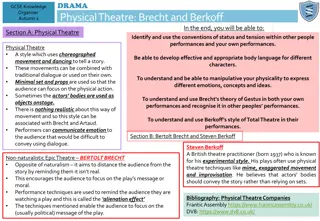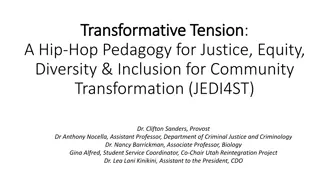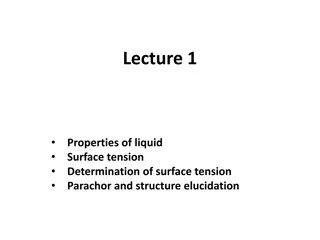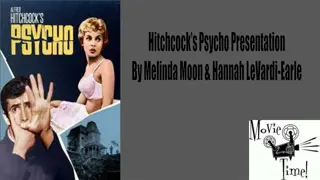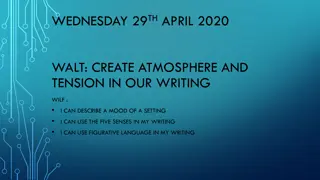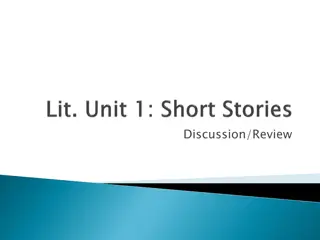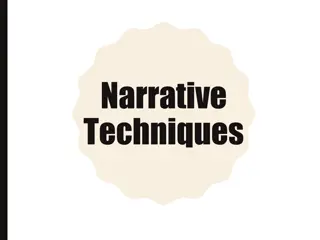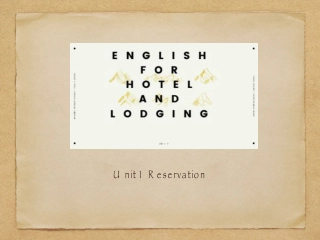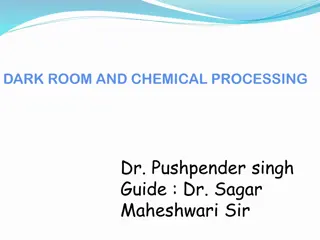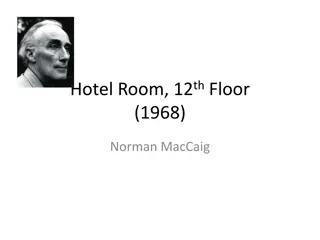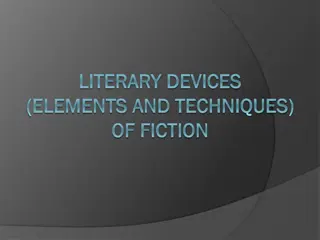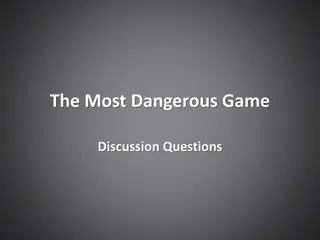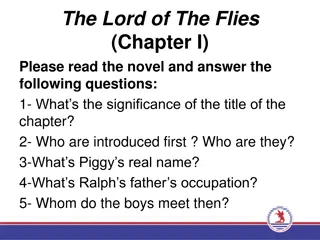Exploring Foreshadowing and Tension in "The Red Room
Dive into the world of foreshadowing and tension in the classic tale "The Red Room" by H.G. Wells. Uncover how the author sets the stage for suspense and anticipates significant events, examining the characters, setting, and storytelling techniques employed. Explore the questions of belief in ghosts and the impact of famous last words in horror narratives.
Download Presentation

Please find below an Image/Link to download the presentation.
The content on the website is provided AS IS for your information and personal use only. It may not be sold, licensed, or shared on other websites without obtaining consent from the author. Download presentation by click this link. If you encounter any issues during the download, it is possible that the publisher has removed the file from their server.
E N D
Presentation Transcript
WEEK FOUR: STRUCTURE AND TENSION
GHOSTS ARE NOT REAL- DISCUSS I CAN ASSURE YOU, SAID I, THAT IT WILL TAKE A VERY TANGIBLE GHOST TO FRIGHTEN ME. CHALLENGE: FAMOUS LAST WORDS WHAT USUALLY HAPPENS TO PEOPLE IN SCARY FILMS/BOOKS WHO SAY THINGS LIKE THIS?
FORSHADOWING Foreshadowing is the writer s way of hinting that something significant or important is going to happen. We, as the reader, get hints or clues before the event itself; this could be through the setting, character or events that take place. If the first line of the story is foreshadowing, what might be the significant or important event ahead for the character?
THE RED ROOM As we read the opening, pick three of the statements below that you feel are true: Underline tension techniques used by Wells: Specific description of the characters The setting Imagery Repetition The narrator does not believe in ghosts. The housekeepers are young and healthy. The young man is forced to spend the night in the red room. The housekeepers refuse to show the narrator to the room. The young man is calm during his walk to the red room. The narrator thinks the housekeepers are old fashioned and superstitious. The young man had no means of protection from supernatural beings.
THE RED ROOM As we read the opening, pick three of the examples of foreshadowing below that you feel are true: Underline tension techniques used by Wells: Specific description of the characters The setting Imagery Repetition The narrator does not believe in ghosts. The housekeepers are young and healthy. The young man is forced to spend the night in the red room. The housekeepers refuse to show the narrator to the room. The young man is calm during his walk to the red room. The narrator thinks the housekeepers are old fashioned and superstitious. The young man had no means of protection from supernatural beings.
HOW DOES WELLS FORESHADOW IN THE OPENING OF THE STORY? How does your extract use foreshadowing within the opening? What is the most effective way that Wells foreshadows? Have you best idea ready to share. Include: Annotate the extract, looking for: Specific verbs or adjectives to describe the housekeepers The technique used What emotion it encourages us to feel Description of the setting Repetition of specific items
HOW WOULD YOU DESCRIBE OUR NARRATOR SO FAR? I can assure you, said I, that it will take a very tangible ghost to frighten me.
THE STORY SO FAR https://www.youtube.com/watch?v=wzPx4R-mHFE TODAY WE WILL BE TRACKING TENSION. WHAT IS TENSION? WHY CAN T THE ENTIRE STORY BE TENSE?
EXPLORING TENSION IN RED ROOM For the event that you rated most highly: As we read, mark a star next to each of these events. Rate each one out of ten for adding tension to the story as a whole. Which techniques have been used by the writer? The narrator enters the room and thinks of the deaths that occurred there. The narrator is unsettled by the dark. The narrator examines the room to alleviate his concerns. The narrator cannot shake the feeling of unease. The narrator begins to light candles as the darkness unsettles him. The wind increases and the candles keep going out. The narrator frantically tries to relight the candles, but cannot manage it. He realises he can light the candles with the fire. The fire dies and the narrator screams, trapped in darkness. Trying desperately to escape, the narrator bangs into things, eventually knocking himself unconscious. How does it cause us to react or what does it make us imagine? What happened before and after the event to emphasise the event itself? CHALLENGE: what creates tension the most: the event or the narrator s reaction?
EXPLORING TENSION IN RED ROOM For the event that you rated most highly: My candle rolled away from me, and I snatched another as I rose. Which techniques have been used by the writer? How does it cause us to react or what does it make us imagine? Let s explode this quotation together. What happened before and after the event to emphasise the event itself? The repetition of the candle throughout the story so far . The verb snatched shows that the narrators feels CHALLENGE: what creates tension the most: the event or the narrator s reaction? This causes us to feel a sense of panic because . The narrator s reaction causes our panic rather than the candle rolling because
EXPLORING TENSION IN RED ROOM HOW MIGHT THIS STORY END?
HOW TO CREATE A CONVINCING ENDING TO A GOTHIC HORROR Look back at your prediction- how will the story end? What would be the most boring/disappointing ending? What believable, convincing endings would fit this type of story best?
HOW TO CREATE A CONVINCING ENDING TO A GOTHIC HORROR Which one would be most suitable? Does your original idea fit? Using either your own idea or those from the list of possible endings, decide which ending you are going to write (150 words) . Now bullet point your ideas for your ending: Wakes up. Rushes downstairs. Housekeepers have his bags ready. Leaves without saying goodbye. Another carriage can be seen approaching in the distance turns around and the housekeepers are staring at it.
HOW TO CREATE A CONVINCING ENDING TO A GOTHIC HORROR Write your own ending (150 words) Top Tips? First person Specific verbs and adjectives Repetition of objects seen earlier in the story A clear choice of ending that may or may not answer all our questions as a reader
LETS READ THE STORY ENDING AND SEE HOW IT COMPARES
HOW TO CREATE A CONVINCING ENDING TO A GOTHIC HORROR There is fear in that room of hers black Fear, and there will be so long as this house of sin endures. Is the room haunted? What haunts it? Was it all in his mind or was there actually a ghost? What has the narrator learnt? What has changed about his relationship with the housekeepers and why is this? Overall, how effective do you find the ending?










